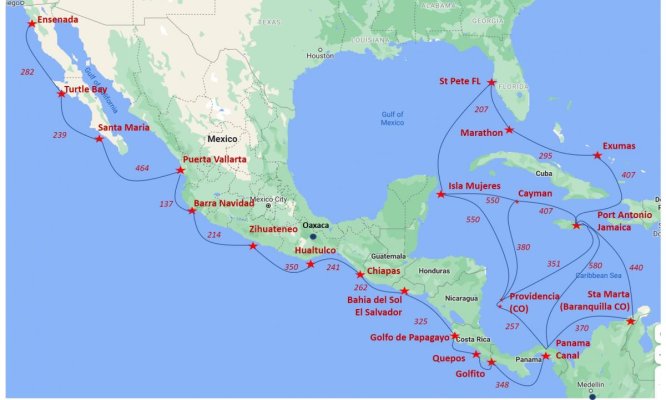mvweebles
Guru
- Joined
- Mar 21, 2019
- Messages
- 7,777
- Location
- United States
- Vessel Name
- Weebles
- Vessel Make
- 1970 Willard 36 Trawler
About half were on Nordhavns, mostly N47s, then N40s, and a few of the last 46s (which are not particularly good in headseas due to fuel tanks being far aft). I ran several 57s, but those were mostly south and one to Fort Lauderdale.Peter, you have a lot of miles under your belt on that route for sure. I would also assume many of those trips were on larger N's?
As far as "apocalyptic weather", I suppose that needs to be put in context. Much smaller boats do this run, including kayaks. I know 2 guys who rowed across the Pacific in a row boat.
The OP has a 420 Sundeck and his original post involved going back and forth every year.
There is no magic to the Nordhavn except to say they are watertight and gear is well fastened so nothing hobbles loose. Those two things - especially being able to endure spray, are two of the most important but under-reported attributes to moving a boat north along the Pacific coast. A LOT of boats can be made to be like that, but boats like Nordhavn come that way. Not much owner intervention needed. Oh, and they are invariably stabilized. But again, not unique to Nordhavn, just common.
I am most knowledgeable about Pacific coast weather so I will not extrapolate, but my experience is you can almost divide the day into 6-hour blocks, at least from late April through end of September. Winds pickup late morning and did down early evening. Peak is around 25-30 kts and seas are around 6-feet at around 7-8 seconds, but only for a few hours. That's when you take the beach route.
Exceptions are the major points of which there are three - Conception, Sal/Buchon, and Mendocino. Heading north, I always timed departure to hit Conception around midnight, but if there's a strong current running, it can still be pretty bumpy for a couple hours. It doesn't always work out that way, but usually does.
I remember being somewhere north of Mendocino one night in a N46. It was pitch black but seas felt pretty big. 10-feet? More? Not sure - always feels worse at night when you can't see. Every so often it felt like we dropped 2-stories down an elevator shaft. The boat speed would stall, the whole boat would shudder, then slowly pickup momentum again. I still managed to get a little sleep. We had some leftover Stouffer's lasagna that we heated on the Lugger engine though opening the fridge was a jack-in-the-box experience. But for the most part, going north wasn't a huge deal. If you waited for a perfect ride, well, it may never come. This is where a powerboat shines vs a sailboat. They are cold, wet, and slow.
My point being is that I define a strong boat differently than most. Stuff has to be well fastened. Ports watertight. For the most part, you are enduring 2-6 hours of junk, not days of it. And there are ways to reduce the effect during those 2-6 hours.
Finally having adequate range so you don't have to waste time going in or out is a huge advantage. Yes, there are plenty of places to stop, but after a while, there isn't anything new. Besides, I just plain enjoy being on the water. The reason I did so many non-stop trips is I just liked it.
Peter
EDiT - the above said, I wouldn't do it for pleasure every year. I'd do it occasionally, but that's it. It's a really long run and a lot can go wrong. Oddly, April is the most consistently windy month on the coast so not a great time to move a boat north but scheduling nudges that direction so your in the PNW in June or so. Schedule is hugely variable. OP is in PNW. Go south to La Paz, spend a season in the Sea of Cortez, ship the boat back to Victoria or Nanaimo. Call it good.
Last edited:



